Loss
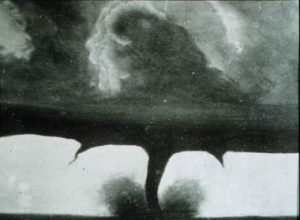 These days, tornado watches and warnings are a normal part of life. They may not happen every day, but when they do sound, we know what to do to stay as safe as possible. The warnings don’t always mean that there are zero deaths from a tornado, but they do help. Unfortunately, the tornado warning sirens, Doppler radar, and television warnings did not exist in 1884. In those days, people had to rely on the skies to tell them what was coming, and as most of us know, that is not always an easy task. In fact, it has taken hundreds of years to even begin to come close to perfecting a system whereby the public could be warned of approaching severe weather, and even then, it hasn’t eliminated the deaths that can occur from these storms.
These days, tornado watches and warnings are a normal part of life. They may not happen every day, but when they do sound, we know what to do to stay as safe as possible. The warnings don’t always mean that there are zero deaths from a tornado, but they do help. Unfortunately, the tornado warning sirens, Doppler radar, and television warnings did not exist in 1884. In those days, people had to rely on the skies to tell them what was coming, and as most of us know, that is not always an easy task. In fact, it has taken hundreds of years to even begin to come close to perfecting a system whereby the public could be warned of approaching severe weather, and even then, it hasn’t eliminated the deaths that can occur from these storms.
One of the largest and most widespread tornado outbreaks in American history happened at a time when warnings did not exist. It happened on this day February 19, 1884, and into February 20, 1884. The precise number of tornadoes, as well as fatalities incurred during the outbreak remains unknown. The outbreak was nicknamed “Enigma outbreak” and is well known by that name. Research of newspaper reports and governmental studies published in the aftermath reveals tornadoes, or in reality, long-track tornado families, struck Alabama,  Georgia, Illinois, Indiana, Kentucky, Mississippi, North Carolina, South Carolina, Tennessee and Virginia. It is estimated that at least 50 tornadoes struck those states that day. Some events that had been counted as tornadoes in initial studies, such as those by John Park Finley, were actually downbursts, especially in northern and northeastern portions of the outbreak. Nevertheless, the damage done was nothing to be overlooked.
Georgia, Illinois, Indiana, Kentucky, Mississippi, North Carolina, South Carolina, Tennessee and Virginia. It is estimated that at least 50 tornadoes struck those states that day. Some events that had been counted as tornadoes in initial studies, such as those by John Park Finley, were actually downbursts, especially in northern and northeastern portions of the outbreak. Nevertheless, the damage done was nothing to be overlooked.
The majority of the reported tornadic activity was seen across Alabama, Georgia, South Carolina and North Carolina, which were all struck severely by multiple waves of tornado families. In the Southeast, the outbreak began during the late morning in Mississippi, preceded by severe thunderstorms in Louisiana. Shortly thereafter, the outbreak widened and intensified, progressing from Alabama to Virginia between noon and midnight. In addition to the outbreak, wind damage, flash floods, with homes swept away by water in Louisville, Kentucky, New Albany, Indiana, and Jeffersonville, Indiana and other towns along the Ohio River, and Derecho-like effects in the Ohio Valley were also reported in published accounts of the outbreak. In case you didn’t know, a Derecho is a widespread, long-lived, straight-line wind storm that is  associated with a land-based, fast-moving group of severe thunderstorms. In addition to that, blizzard conditions occurred in the eastern Midwest, as a part of this storm series. According to an article appearing in the Statesville, North Carolina Landmark three days later, the damage tally in Georgia alone was estimated to be $1 million, in 1884 dollars. Today, the damage would have been approximately $23,660,667. That is an astounding figure, and that is just the property damage numbers. Loss of life simply cannot be measured in money. In fact, the greatest mystery surrounding this horrific event is the possibility that, in all likelihood, as many as 1,200 people lost their lives that day at the hands of the 1884 Enigma Tornado Outbreak.
associated with a land-based, fast-moving group of severe thunderstorms. In addition to that, blizzard conditions occurred in the eastern Midwest, as a part of this storm series. According to an article appearing in the Statesville, North Carolina Landmark three days later, the damage tally in Georgia alone was estimated to be $1 million, in 1884 dollars. Today, the damage would have been approximately $23,660,667. That is an astounding figure, and that is just the property damage numbers. Loss of life simply cannot be measured in money. In fact, the greatest mystery surrounding this horrific event is the possibility that, in all likelihood, as many as 1,200 people lost their lives that day at the hands of the 1884 Enigma Tornado Outbreak.

 When we think of a series of disasters, it is usually tornadoes, earthquakes, or floods that come to mind. On February 11, 1952, none of the usual suspects were at fault in the series of disasters that began across central Europe. Snow storms don’t normally fall into the category of a series of disasters, but when a storm stalled over middle Europe during the first week of February of 1952, it dumped two feet of snow in parts of France, Austria, Switzerland, and Germany. In the vast area of middle Europe, life quickly ground to a standstill. Everything was closed, and travel was impossible. Germany recruited thousands of people and their shovels in an attempt to make the streets passable. In France several people died when their roofs collapsed under the weight of the heavy snow accumulation.
When we think of a series of disasters, it is usually tornadoes, earthquakes, or floods that come to mind. On February 11, 1952, none of the usual suspects were at fault in the series of disasters that began across central Europe. Snow storms don’t normally fall into the category of a series of disasters, but when a storm stalled over middle Europe during the first week of February of 1952, it dumped two feet of snow in parts of France, Austria, Switzerland, and Germany. In the vast area of middle Europe, life quickly ground to a standstill. Everything was closed, and travel was impossible. Germany recruited thousands of people and their shovels in an attempt to make the streets passable. In France several people died when their roofs collapsed under the weight of the heavy snow accumulation.
The worst of the storm, however, was felt in Austria, when a series od deadly avalanches took a heavy death toll. It was during the early hours of February 11, 1952, at a ski resort in Melkoede, when a huge mass of the newly fallen snow suddenly crashed down the mountain from above. There was no time to react, and no time to get away. They were trapped. Fifty people were sleeping at the resort. Twenty of them, mostly German tourists were killed, and another ten were seriously injured. In Switzerland and Austria, authorities issued urgent warnings about potential avalanches and some villages were actually evacuated. Nevertheless, all that was not enough. The next day there were more damaging avalanches. In Isenthal, Switzerland, hundreds of cattle and several barns were buried by an avalanche. In Leutasche, Austria, a twelve year old child was saved by people who risked their own lives in the face of a second avalanche that was poised to fall. Seven members of the child’s family were killed by the avalanche.
Avalanches kill more than 150 people worldwide each year. Most are snowmobilers, skiers, and snowboarders, and most deadly avalanches are triggered by the victim or someone in their party. Given that count, I suppose that the 78 people who perished in the February avalanches in middle Europe in 1952, might seem like a small number, but when you consider that these deaths occurred over a period of a few days, and the rest of the deaths by avalanches from that year were not included in that number, the death toll is staggering. This was not the worst avalanche death toll, however. That record, if it is right to call it such, goes to the Huascarán avalanche that was triggered by the 1970 Ancash earthquake in Peru. On 31 May 1970, the Ancash earthquake caused a substantial part of the north side of the mountain to collapse. The avalanche mass, an 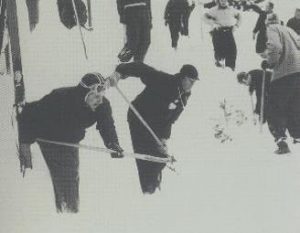
 estimated 80 million cubic feet of ice, mud and rock, was about half a mile wide and a mile long. It advanced about 11 miles at an average speed of 175 to 200 miles per hour, burying the towns of Yungay and Ranrahirca under ice and rock, killing more than 20,000 people. This avalanche, in my estimation, might have been more of a landslide than an avalanche, and so it’s very possible that all of these people would have died had there been snow or not.
estimated 80 million cubic feet of ice, mud and rock, was about half a mile wide and a mile long. It advanced about 11 miles at an average speed of 175 to 200 miles per hour, burying the towns of Yungay and Ranrahirca under ice and rock, killing more than 20,000 people. This avalanche, in my estimation, might have been more of a landslide than an avalanche, and so it’s very possible that all of these people would have died had there been snow or not.
 Early in my married life, I met a precious part of my husband, Bob’s family, in the form of his great grandparents, Edgar and Nellie Knox; his great aunt and uncle, Helen and Frank Knox; and their youngest son, Richard. They were wonderful people, and I loved them right away. I always thought it was awesome of Frank and Helen to bring their parents out to Casper to visit their son, Bob Knox’s family, of which I was a part. At that time, I didn’t really have a lot of time to get to know Frank and Helen, but got to know them on subsequent trip, and found them to be very interesting…but, little did I know, that I had only scratched the surface of who these people were.
Early in my married life, I met a precious part of my husband, Bob’s family, in the form of his great grandparents, Edgar and Nellie Knox; his great aunt and uncle, Helen and Frank Knox; and their youngest son, Richard. They were wonderful people, and I loved them right away. I always thought it was awesome of Frank and Helen to bring their parents out to Casper to visit their son, Bob Knox’s family, of which I was a part. At that time, I didn’t really have a lot of time to get to know Frank and Helen, but got to know them on subsequent trip, and found them to be very interesting…but, little did I know, that I had only scratched the surface of who these people were.
After Helen’s passing recently, I found out so much more about her childhood, and the life she and Frank lived. In many ways, it was destiny that they should meet. Helen’s family had moved to California because of her mother’s illness, and after her mother passed away, the three older children were raised by her mother’s sister, while her younger siblings were adopted out. It was a sad time for Helen, but when she grew up, she decided to earn a degree in Social Work. When World War II finally drew the United States into it’s clutches, Helen became active in the USO, and it was then, during a homecoming dance, that she met a handsome young captain, named Richard F (Frank) Knox. They were smitten with each other right away, and married on June 13, 1946.
It was time then for Frank to go to college, so they moved to Pullman, Washington and he attended Washington State College, now Washington State University. When he graduated, Frank and Helen had planned to move to Vanport, Washington for a job he had lined up, with the Clark County PUD in Vancouver, WA, but the Vanport Flood of May 30, 1948 ended that dream. The flood wiped out the up and coming town of Vanport, Oregon, leaving no housing for Frank and Helen. It was then that Frank took an instructor position in Pullman, Washington, and that was where he and Helen lived for the next 40 years, and raised their five sons, Robert, David, Greg, Wesley, and Richard. I find it amazing, how God can have a different plan for us than our plan. I  don’t know how things might have worked out had the flood not happened, but Frank and Helen and their sons lived a wonderful life in Pullman, Washington.
don’t know how things might have worked out had the flood not happened, but Frank and Helen and their sons lived a wonderful life in Pullman, Washington.
With Helen’s passing, comes a new kind of loneliness for Frank, and I am glad that he has his wonderful sons and their families to help him get through this difficult time. Nothing will ever replace the love of his life, and I’m sure that this…the first birthday without he beloved soul mate, Helen, will be a difficult on for Frank, and I will be keeping him in prayer today and always, that the Lord with comfort him all the days of his life. Today is Frank’s 97th birthday. Happy birthday Frank!! Have a great day!! We love you!!
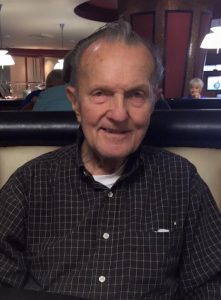 Not every person in a family is related by blood…or even by marriage. Sometimes, a lifelong friend is, in reality, as close as family. Such is the case with Burl Ford. Burl was one of the neighborhood kids that my mother, Collene Byer Spencer and her siblings played with as children. The first time I heard that they had been childhood friends, I was amazed, because by that time, we were living just down the street from Burl and his family, and in fact we were all friends, with them and their kids. Burl’s kids, Lisa, Susie, Burly, and Judy, were all in gymnastics, and his wife, Thea had learned how to coach and spot for the tumbling. So when my younger sisters and I were at their house, the natural next step was to do tumbling in their basement. It was Thea who instilled in me, the love of gymnastics, which I continued doing through high school.
Not every person in a family is related by blood…or even by marriage. Sometimes, a lifelong friend is, in reality, as close as family. Such is the case with Burl Ford. Burl was one of the neighborhood kids that my mother, Collene Byer Spencer and her siblings played with as children. The first time I heard that they had been childhood friends, I was amazed, because by that time, we were living just down the street from Burl and his family, and in fact we were all friends, with them and their kids. Burl’s kids, Lisa, Susie, Burly, and Judy, were all in gymnastics, and his wife, Thea had learned how to coach and spot for the tumbling. So when my younger sisters and I were at their house, the natural next step was to do tumbling in their basement. It was Thea who instilled in me, the love of gymnastics, which I continued doing through high school.
Cheryl remembers playing Jacks on the patio in their back yard with Burl. That is an unusual thought, because Jacks was primarily a girls game…at least in school. Burl didn’t care about that. He loved kids, and playing with his kids and the neighbor kids ![16387182_10202403016154753_4437392044467414144_n[1]](https://carynschulenberg.com/wp-content/uploads/2017/02/16387182_10202403016154753_4437392044467414144_n1-300x225.jpg) was totally within his nature…and in fact, growing up was totally not in his nature. Burl was a kid all his life. And…Burl loved his pranks!! I suppose these days he might have found himself in trouble, but those were different times. One prank, in particular, that lots of their family friends remember is the cherry bombs. In those days, kids could safely have sleep overs in someone’s back yard. The Ford’s back yard had a slight slope to it, and made for a perfect sleep over spot…in theory. You did have to take Burl into account. He would wait until we were all settled out there sleeping, and out of the blue, in the middle of the night…a cherry bomb would go off. Burl was careful of course, and never threw it near anyone, but it was something that definitely got your attention.
was totally within his nature…and in fact, growing up was totally not in his nature. Burl was a kid all his life. And…Burl loved his pranks!! I suppose these days he might have found himself in trouble, but those were different times. One prank, in particular, that lots of their family friends remember is the cherry bombs. In those days, kids could safely have sleep overs in someone’s back yard. The Ford’s back yard had a slight slope to it, and made for a perfect sleep over spot…in theory. You did have to take Burl into account. He would wait until we were all settled out there sleeping, and out of the blue, in the middle of the night…a cherry bomb would go off. Burl was careful of course, and never threw it near anyone, but it was something that definitely got your attention.
Today, we said goodbye to Burl…all of his friends and family. It was a beautiful service filled with happy 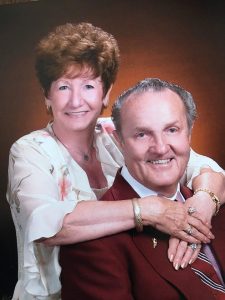 memories, and yes, the shedding of tears. Thea’s sisters reminded us of his love of sports, including the Broncos and the Colorado Rockies, as well as the Super Bowl games he got to attend, and throwing out the first pitch at a Rockies game. They told of his love of fishing, camping, snowmobiling, golf, travel, and precious time spent at their mountain cabin. And they told us about the many pranks and his bag of tricks. Burl was a member of the Oil City Slickers and Gentleman’s touch, both barber shop musical groups. The group sang at his service, and it occurred to me that, while the songs were beautiful, there was one voice missing. Those were wonderful memories, but it was something the minister said that particularly struck me as amazing. As he told of his last visits with Burl, and many before that, he said that the one thing he noticed was that Burl was always so happy and full of life. Then, he said that he wished that he could take some of Burl’s happy, joyous spirit and zest for life, and throw it out into the world. Instinctively, I thought…just pack it in a cherry bomb.
memories, and yes, the shedding of tears. Thea’s sisters reminded us of his love of sports, including the Broncos and the Colorado Rockies, as well as the Super Bowl games he got to attend, and throwing out the first pitch at a Rockies game. They told of his love of fishing, camping, snowmobiling, golf, travel, and precious time spent at their mountain cabin. And they told us about the many pranks and his bag of tricks. Burl was a member of the Oil City Slickers and Gentleman’s touch, both barber shop musical groups. The group sang at his service, and it occurred to me that, while the songs were beautiful, there was one voice missing. Those were wonderful memories, but it was something the minister said that particularly struck me as amazing. As he told of his last visits with Burl, and many before that, he said that the one thing he noticed was that Burl was always so happy and full of life. Then, he said that he wished that he could take some of Burl’s happy, joyous spirit and zest for life, and throw it out into the world. Instinctively, I thought…just pack it in a cherry bomb.
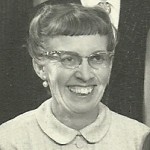
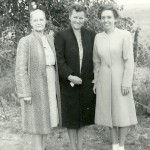 The first time I met my husband, Bob Schulenberg’s great Uncle Frank Knox and his sweet wife, Helen, was in the summer of 1976, when they and their son, Richard so graciously brought Frank’s parents, Edgar and Nellie Knox to Casper to visit their son Robert’s family, of which I was now a member. It was such a kind act for them to bring Edgar and Nellie, and it showed the kind spirits that they were. Edgar and Nellie were getting on in years, as was their son Robert, who was their eldest son. Edgar was 93 years old at the time, and little did any of us know, that his life was nearer its end than anyone could have expected. The visit took place the end of July of 1976, and Edgar would pass away on August 28, 1976, just about a month later. Nellie would live another 8 years and was blessed in that Frank and Helen would again bring her out to Casper for a visit, about four years later. Again, I was moved by the acts of kindness they showed to Frank’s parents. Nellie passed away on February 10, 1984, at 97 years old, having lived a good long life.
The first time I met my husband, Bob Schulenberg’s great Uncle Frank Knox and his sweet wife, Helen, was in the summer of 1976, when they and their son, Richard so graciously brought Frank’s parents, Edgar and Nellie Knox to Casper to visit their son Robert’s family, of which I was now a member. It was such a kind act for them to bring Edgar and Nellie, and it showed the kind spirits that they were. Edgar and Nellie were getting on in years, as was their son Robert, who was their eldest son. Edgar was 93 years old at the time, and little did any of us know, that his life was nearer its end than anyone could have expected. The visit took place the end of July of 1976, and Edgar would pass away on August 28, 1976, just about a month later. Nellie would live another 8 years and was blessed in that Frank and Helen would again bring her out to Casper for a visit, about four years later. Again, I was moved by the acts of kindness they showed to Frank’s parents. Nellie passed away on February 10, 1984, at 97 years old, having lived a good long life.
I am reminded of the fourth Commandment of God, which says, “Honor thy father and thy mother, that it may be well with thee, and thou mayest live long on the earth.” I know that for their kind and loving acts, over the years, Frank and Helen have been very blessed. Frank and Helen married on June 13, 1946. Their marriage was blessed with five sons, Robert, David, Gregory, Wesley, and Richard. They were good people, and raised good children, and the rest of the family feels very blessed to have known them. Over the years, they made several trips to Casper, and it was always fun to see them. Frank and Helen have long since retired, and their memories have faded, which I find very sad, because they both had amazing minds. They knew so much and they were willing to share their knowledge with anyone who was interested in listening. The last time I spoke to Frank was when my father-in-law, Walt Schulenberg passed away. I could tell that his memory was diminished, but it was a good visit, and he did remember some things He told me that Helen’s memory wasn’t as good as his was, and that made me sad too. I haven’t spoken to her in a number of years.
Last might, we got the word, that Helen had passed away on January 11, 2017. While I was very sad that she is gone, I know that she was very blessed. You see, Helen was 99 years old. How many people get to live to be 
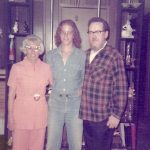 99 years old. Helen’s kindness over the years to everyone she knew, but especially to her parents and to Frank’s parents have given her the benefit of God’s promise of a long life, and since Frank is still living, at 96 years old, it is very obvious that he will also reap the benefit of that same promise. They are both wonderful people. Rest now in peace, Helen Knox. You will be greatly missed, but I know that you are happy in Heaven, and your memory has been restored to you again. We love you, and miss you already.
99 years old. Helen’s kindness over the years to everyone she knew, but especially to her parents and to Frank’s parents have given her the benefit of God’s promise of a long life, and since Frank is still living, at 96 years old, it is very obvious that he will also reap the benefit of that same promise. They are both wonderful people. Rest now in peace, Helen Knox. You will be greatly missed, but I know that you are happy in Heaven, and your memory has been restored to you again. We love you, and miss you already.
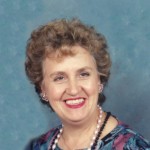
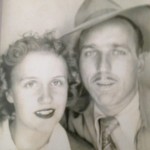 New Year’s Eve and New Year’s Day have always held a special place of significance in my family, because my mother, Collene Spencer was born on New Year’s Day. We always held a New Year’s Eve party, and I guess as kids, we thought that everyone did that, but it wasn’t so. I know lots of people have a party on New Year’s Eve, but not really as many as I had always thought. Most people just go out to a bar, and celebrate with a large group of people, but that would never have been the same thing in our family. Now that Mom is in Heaven, we still have the party, and as many of us as can, come to it. We do it in honor of Mom, because even though she is in Heaven…it’s still her special day. The traditional beating the pans…which my mom came up with, because we didn’t have noisemakers years ago, just doesn’t feel the same, however. That was always a favorite part for Mom. Once we rang the new year in right, we all go around to each other and wish each other a Happy New Year…and for Mom, a happy birthday. Then we all sang happy birthday to her. Of course, this wasn’t her birthday party…that would come on New Year’s Day. It was a two day celebration in Mom’s honor. Some things just cannot stay the same after the passing of a loved one, and I suppose this is one of them. We can tall Mom happy birthday, but not in person.
New Year’s Eve and New Year’s Day have always held a special place of significance in my family, because my mother, Collene Spencer was born on New Year’s Day. We always held a New Year’s Eve party, and I guess as kids, we thought that everyone did that, but it wasn’t so. I know lots of people have a party on New Year’s Eve, but not really as many as I had always thought. Most people just go out to a bar, and celebrate with a large group of people, but that would never have been the same thing in our family. Now that Mom is in Heaven, we still have the party, and as many of us as can, come to it. We do it in honor of Mom, because even though she is in Heaven…it’s still her special day. The traditional beating the pans…which my mom came up with, because we didn’t have noisemakers years ago, just doesn’t feel the same, however. That was always a favorite part for Mom. Once we rang the new year in right, we all go around to each other and wish each other a Happy New Year…and for Mom, a happy birthday. Then we all sang happy birthday to her. Of course, this wasn’t her birthday party…that would come on New Year’s Day. It was a two day celebration in Mom’s honor. Some things just cannot stay the same after the passing of a loved one, and I suppose this is one of them. We can tall Mom happy birthday, but not in person.
Sometimes, I think God places people in our lives for a specific moment and a specific reason. As my husband, Bob and I were leaving Denny’s this morning, after having breakfast, I glanced at a couple sitting in a booth we passed on our way out. At first glance, the woman looked a lot like my mother when she was young…enough so, in fact, that I had to do a double take. Yes, there were similarities, but she didn’t really look enough like Mom to mistake her for my mom after a good look, but I walked out of the restaurant smiling anyway, because it seemed such a sweet gift from God. It was like seeing my mom on her birthday! Of course, I know it wasn’t her, nor did the woman look totally like her, but rather it just seemed like a reminder that she is with God, and that she is very happy. Mom had been on my mind much more than usual for the past several days…probably because of her birthday. Nevertheless, that woman, in that place, for that moment, made me smile, because just for a second, at a quick glance, she reminded me of my mom.
As with my dad, I somehow never expected to live one day on this earth without my mom here on Earth. We were always such a close family, and I never expected that to change, and in reality, I suppose it hasn’t. 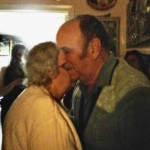
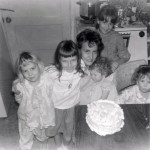 Rather, we just have to wait to see our parents again. That is the sad part about getting on with life after your parents have gone to Heaven. You have to take the reigns, and lead your family in the way they should go, just like your parents did, but often you still feel like that little daughter would love to ask your parents’ advise about life again. There is a little joke on Facebook about wishing you were a kid again. Basically, I want my mommy and daddy. I’m tired of adulting.” Today would have been my mom’s 81st birthday. Happy birthday in Heaven Mom. We love and miss you very much.
Rather, we just have to wait to see our parents again. That is the sad part about getting on with life after your parents have gone to Heaven. You have to take the reigns, and lead your family in the way they should go, just like your parents did, but often you still feel like that little daughter would love to ask your parents’ advise about life again. There is a little joke on Facebook about wishing you were a kid again. Basically, I want my mommy and daddy. I’m tired of adulting.” Today would have been my mom’s 81st birthday. Happy birthday in Heaven Mom. We love and miss you very much.


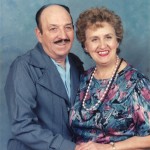 On the last day of the year, many people are busily planning the festivities for the evening. Others are contemplating the coming year and how they might make it better than the last. These are things that I am doing too, but I am also looking back on the year that is quickly coming to a close. Every year has it’s good things and it’s bad things. This year is no different. As the year began, I was recovering from a broken shoulder, while my niece, Chantel Balcerzak was getting used to her new role as grandma to little Izabella Siara Harman. February brought a promotion for my brother-in-law, Chris Hadlock to Lieutenant with the Casper Police Department, and then the sad 1st anniversary of our mother’s passing. I couldn’t believe she had been gone a year already. March brought the 41st anniversary of my marriage to Bob Schulenberg, and the love continues to grow. It also brought the purchase of a home in northwestern Washington for our daughter, Amy Royce and her husband, Travis.
On the last day of the year, many people are busily planning the festivities for the evening. Others are contemplating the coming year and how they might make it better than the last. These are things that I am doing too, but I am also looking back on the year that is quickly coming to a close. Every year has it’s good things and it’s bad things. This year is no different. As the year began, I was recovering from a broken shoulder, while my niece, Chantel Balcerzak was getting used to her new role as grandma to little Izabella Siara Harman. February brought a promotion for my brother-in-law, Chris Hadlock to Lieutenant with the Casper Police Department, and then the sad 1st anniversary of our mother’s passing. I couldn’t believe she had been gone a year already. March brought the 41st anniversary of my marriage to Bob Schulenberg, and the love continues to grow. It also brought the purchase of a home in northwestern Washington for our daughter, Amy Royce and her husband, Travis.
April brought my 60th birthday, although I felt no upset by that. I have always felt that the key is to enjoy the age you are at, and I will continue to do so. May 5th brought the sad reminder that my father-in-law, Walt Schulenberg has been in Heaven for 3 years now. May also brought the graduation of my grandson, Chris 

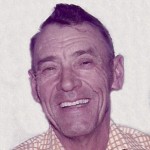 Petersen from the Culinary School at Sheridan College. It’s hard for me to believe that his college years are so quickly over. My daughter, Amy made the trip to Wyoming to attend the graduation, and it was so good to see her again…even if it was for such a short time. June brings the birthdays of my daughters, and these days it’s a little bit bittersweet, because Amy is so far away. My oldest daughter, Corrie Petersen and her husband, Kevin went camping for her birthday, so we joined them on Casper Mountain for a birthday evening. We all had a lovely time. I just wish Amy’s family could have been there too.
Petersen from the Culinary School at Sheridan College. It’s hard for me to believe that his college years are so quickly over. My daughter, Amy made the trip to Wyoming to attend the graduation, and it was so good to see her again…even if it was for such a short time. June brings the birthdays of my daughters, and these days it’s a little bit bittersweet, because Amy is so far away. My oldest daughter, Corrie Petersen and her husband, Kevin went camping for her birthday, so we joined them on Casper Mountain for a birthday evening. We all had a lovely time. I just wish Amy’s family could have been there too.
July brought with it one of the biggest changes of my life, when my husband, Bob Schulenberg retired from the City of Casper. It was a day of rejoicing, because he had been ready to retire for some time now. July also brought with it, another loss…of sorts, when my granddaughter, Shai Royce moved to Washington to be near her family. It was hard on me, but I knew it was best for her, because she had been so lonely for her parents and her brother, Caalab. While we continue to miss her and the rest of her family, we are happy, because they are happy. July also brought wedding bells for my nephew, Garrett Stevens as he married his best friend, 

 Kayla Smiley. August brought a beautiful new addition to our family when my niece Jessi Sawdon and her husband, Jason welcomed daughter Adelaide Ione to our family. Addi was named after Jessi’s great grandmother and Jessi’s grandmother, my mom, Collene Ione Spencer. In September, my sister-in-law, Brenda Schulenberg, had skin removal surgery after losing 350 pounds. She had a bleeding issue, but she is doing well now, and we are very proud of her. September also brought with it the sadness of loss, as we said goodbye to Bob’s aunt, Linda Cole. Hers was a shock, because her passing was so unexpected.
Kayla Smiley. August brought a beautiful new addition to our family when my niece Jessi Sawdon and her husband, Jason welcomed daughter Adelaide Ione to our family. Addi was named after Jessi’s great grandmother and Jessi’s grandmother, my mom, Collene Ione Spencer. In September, my sister-in-law, Brenda Schulenberg, had skin removal surgery after losing 350 pounds. She had a bleeding issue, but she is doing well now, and we are very proud of her. September also brought with it the sadness of loss, as we said goodbye to Bob’s aunt, Linda Cole. Hers was a shock, because her passing was so unexpected.
October found my grandson, Josh Petersen actively pursuing his dream of becoming a firefighter as he took Boces classes to get a head start on the Fire Science degree he needs. It also found us celebrating with my brother-in-law, Chris Hadlock, as he became the Peace Officer of the year. November brought an unusual Thanksgiving as Bob and I traveled to Ferndale, Washington to spend the holiday with Amy’s family, in a week that went by way too fast. Then, as we were on our way home, we found out about the passing of my cousin, Shirley Cameron’s husband, Shorty’s passing…another shocking passing that was very unexpected. December 

 brought the sad reminder that my dad, Allen Spencer had been in Heaven now for 9 long years. That seems impossible to me. December also brought college graduation for my niece, Michelle Stevens, who will now start her teaching career. This was most certainly a year of ups and downs, but with the coming new year, comes the hope for a great future.
brought the sad reminder that my dad, Allen Spencer had been in Heaven now for 9 long years. That seems impossible to me. December also brought college graduation for my niece, Michelle Stevens, who will now start her teaching career. This was most certainly a year of ups and downs, but with the coming new year, comes the hope for a great future.
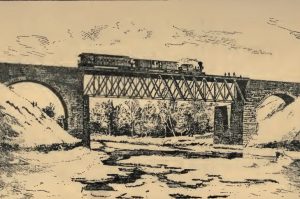 Through the centuries, new designs were developed to build things we needed. As the railroad moved across the nation, track laying came across deep gorges and flat plains. Of course, the flat plains were easy to deal with, and trains could simply go around any hills in the area, but the rivers and gullies were a bigger problem. They needed bridges, and so Charles Collins and Amasa Stone jointly designed a bridge to be used at Ashtabula, Ohio. It was the first Howe-type wrought iron truss bridge built. Collins was worried about the bridge, thinking that it was “too experimental” and needed further evaluation. Nevertheless, higher powers prevailed, and the bridge was built. Collins had been right to be concerned. The bridge lasted just 11 years before it collapsed.
Through the centuries, new designs were developed to build things we needed. As the railroad moved across the nation, track laying came across deep gorges and flat plains. Of course, the flat plains were easy to deal with, and trains could simply go around any hills in the area, but the rivers and gullies were a bigger problem. They needed bridges, and so Charles Collins and Amasa Stone jointly designed a bridge to be used at Ashtabula, Ohio. It was the first Howe-type wrought iron truss bridge built. Collins was worried about the bridge, thinking that it was “too experimental” and needed further evaluation. Nevertheless, higher powers prevailed, and the bridge was built. Collins had been right to be concerned. The bridge lasted just 11 years before it collapsed.
On December 28, 1876, a Lake Shore and Michigan Southern Railway train…the Pacific Express left New York. It struggled along through the drifts and the blinding storm. The train was pulling into Ashtabula, Ohio, shortly before 8:00pm on December 29, 1876, several hours behind schedule. The eleven cars were a heavy burden to the two engines. The leading locomotive broke through the drifts beyond the ravine, and rolled on across the bridge at Ashtabula at less than ten miles an hour. The head lamp could barely be seen because the air was thick with the driving snow. The leading engine reached solid ground, and the engineer had just given it steam…when something in the undergearing of the bridge snapped.
What followed was a horror beyond horrors…not only for the victims, but for the rescuers as well…maybe even more so for the rescuers. As the bridge crumbled beneath the weight of the train, the train and its 159 passengers fell 70 feet into the river below. More than 90 people, passengers and crew, were killed when the train hit the river and ignited into a huge ball of flames. Only the lead engine escaped the fall. As the bridge fell, the engineer gave it a quick head of steam, which tore the draw head from its tender, and the liberated engine shot forward and buried itself in the snow. The engineer escaped with a broken leg. The proportions of the Ashtabula horror are still only approximately known. Daylight, brought with it the opportunity to find and count the saved. It also revealed the fact that two out of every three passengers on the train were lost. Of the 160 passengers who the injured conductor reports as having been on board, fifty nine were found or accounted for as surviving. The remaining 100, burned to ashes or shapeless lumps of charred flesh, were lying under the ruins of the bridge and train. Every possible element of horror was there. First came the crash of the bridge, the agonizing moments of suspense as the seven laden cars plunged down their fearful leap to the icy riverbed. Then the fire, that devoured all that had been left alive by the crash. The water that gurgled up from under the broken ice brought with it another form of death. And finally, the biting blast of freezing air filled with snow, that froze those who had escaped the water and fire.
For the rescuers, the horror had just begun. I can’t think of anything worse than seeing those bodies after they were horribly mangled, drowned, and burned…some beyond recognition, some completely cremated. The number of persons killed cannot be accurately stated, because it is not known exactly how many there were on the train. It is supposed that some of the bodies were entirely consumed in the flames, as well. The official list of those killed and those who have died of their injuries, gives the number as fifty five, but it is suspected to be somewhat higher. There is no death list to report…and in fact, there can be none. There are no remains that can ever be identified. The three charred, shapeless lumps recovered were burned beyond recognition. For the rest, there are piles of white ashes in which were found the crumbling particles of bones. In other places masses of black, charred debris, half under water, which may contain fragments of bodies, but nothing that resembled a human body. It is thought that there may have been a few corpses under the ice, as there were women and children who jumped into the water and sank, but none have been recovered. Periodically, as people began looking for people that were missing around the country, and they were able to place them, as possibly on the train, more supposed victims have been identified…at least there is the possibility that they were a victim.
The Ashtabula, Ohio Railroad Disaster, often referred to simply as the Ashtabula Disaster or the Ashtabula Horror, was one of the worst railroad disasters in American history. The event occurred just 100 yards from the railroad station at Ashtabula, Ohio. It’s topped only by the Great Train Wreck of 1918 in Nashville, Tennessee. Charles Collin, the chief engineer, who knew as few men did the defects of that bridge, but was powerless to repair them, had been listening for this very crash for years. Collins, locked himself in his bedroom and shot himself while the inquest was in progress rather than tell the world all he believed he knew. Collins was found 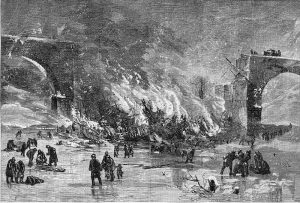 dead in his bedroom of a gunshot wound to the head. He had tendered his resignation to the Board of Directors the previous Monday. Collins was believed to have committed suicide out of grief and feeling partially responsible for the tragic accident, however, a police report at the time suggested the wound had not been self inflicted. Documents discovered in 2001 and an examination of Collins’ skull suggest that he had indeed been murdered. Amasa Stone committed suicide seven years later after experiencing financial difficulties with some foundries he had interests in, suffering from severe ulcers that kept him from sleeping, and scorn from the public over the disaster.
dead in his bedroom of a gunshot wound to the head. He had tendered his resignation to the Board of Directors the previous Monday. Collins was believed to have committed suicide out of grief and feeling partially responsible for the tragic accident, however, a police report at the time suggested the wound had not been self inflicted. Documents discovered in 2001 and an examination of Collins’ skull suggest that he had indeed been murdered. Amasa Stone committed suicide seven years later after experiencing financial difficulties with some foundries he had interests in, suffering from severe ulcers that kept him from sleeping, and scorn from the public over the disaster.
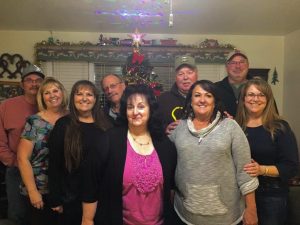 Last night my sisters and I, along with our families, got together for our 2nd annual Spencer Family Christmas Party. Our family made a commitment long ago, to stay close as a family. Family is so important, and all too often, people lose touch, because they don’t realize the importance of family, or they think there will always be time later. It is never a good idea to put off family until later. I’m thankful that my mom’s parents, George and Hattie Byer asked their kids to stay close, inspiring the annual picnic and Christmas parties to keep us all close, because it was those events, that gave us the inspiration to do the same. Then, our sister, Allyn Hadlock, and her husband Chris decided to host the annual party at their house. What a wonderful blessing that has been for all of us. This year was a smaller crowd, as there were several family members who will be spending Christmas in various locations across the United States, but I know they were there in
Last night my sisters and I, along with our families, got together for our 2nd annual Spencer Family Christmas Party. Our family made a commitment long ago, to stay close as a family. Family is so important, and all too often, people lose touch, because they don’t realize the importance of family, or they think there will always be time later. It is never a good idea to put off family until later. I’m thankful that my mom’s parents, George and Hattie Byer asked their kids to stay close, inspiring the annual picnic and Christmas parties to keep us all close, because it was those events, that gave us the inspiration to do the same. Then, our sister, Allyn Hadlock, and her husband Chris decided to host the annual party at their house. What a wonderful blessing that has been for all of us. This year was a smaller crowd, as there were several family members who will be spending Christmas in various locations across the United States, but I know they were there in  spirit. Of course we missed each one of them, but we understand. I hope that maybe one day, we will be able to have a party with all of us together again.
spirit. Of course we missed each one of them, but we understand. I hope that maybe one day, we will be able to have a party with all of us together again.
The one thing that I have noticed about each of the two parties we have had since our parents left us, is that when we are having the party, it’s like Mom and Dad are there with us. Part of the reason is because of the fact that the conversation always turns to them, and to Christmastimes of the past. The memories of special gifts given and received, moments of surprise, and comical moments too, flood the room…along with the laughter as we reminisce about the Christmases of our lifetimes. Still, it always leaves us with an almost bittersweet feeling. Sweetness, because we have been blessed with such great parents, and that we are making the proud, but bitter, because they aren’t here with us. Nevertheless, we know that we will all be together again.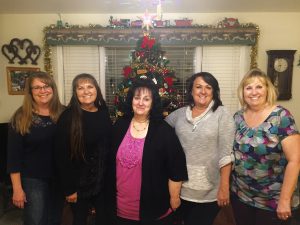
We really have been blessed with wonderful sisters, and all of the other family members. The family has grown exponentially. Like my mom’s family, we are related to about half of the town. That part in itself is an amazing and wonderful thing. We all feel very blessed by all of the nieces and nephews, grandchildren and great grandchildren, and the wonderful additions that have joined us by marriage. This time of year, we start to think more and more about family, and while I miss my parents more that I could ever say, I am thankful for my sisters, everyday, because sisters really are forever friends.
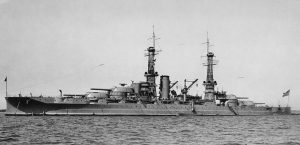 Most people know that the USS Arizona was one of the ships that was bombed when the Japanese attacked Pearl Harbor on December 7, 1941. The USS Arizona’s sinking took with it, 1,177 men…almost half of the total of 2,403 people killed at Pearl Harbor. The Arizona was one of 20 American ships and more than 300 airplanes lost that day. We know that the attack woke the sleeping giant that is the United States, and we joined World War II with the Allies to stop the tyranny that was Japan and later Germany and Italy. Most people know that the Allies were successful in World War II, and after four long years and the loss of over 400,000 lives, the war was over. There are a few facts about the USS Arizona that many people might not know, however.
Most people know that the USS Arizona was one of the ships that was bombed when the Japanese attacked Pearl Harbor on December 7, 1941. The USS Arizona’s sinking took with it, 1,177 men…almost half of the total of 2,403 people killed at Pearl Harbor. The Arizona was one of 20 American ships and more than 300 airplanes lost that day. We know that the attack woke the sleeping giant that is the United States, and we joined World War II with the Allies to stop the tyranny that was Japan and later Germany and Italy. Most people know that the Allies were successful in World War II, and after four long years and the loss of over 400,000 lives, the war was over. There are a few facts about the USS Arizona that many people might not know, however.
Twenty three sets of brothers died aboard USS Arizona. In all there were 37 confirmed pairs or trios of brothers assigned to the ship. Of the 77 men in those sets, 62 were killed. Only one full set of brothers survived. Kenneth and Russell Warriner survived because Kenneth was away at flight school in San Diego, and Russell, while badly wounded, lived. Also on board were father and son, Thomas Free and his son William who served and were killed aboard the Arizona that day. While no regulation exists, US officials discouraged siblings serving on the same ship after the Pearl Harbor attack. In addition to these men who died, the USS Arizona’s entire band, all 21 members, known as US Navy Band Unit (NBU) 22, were lost in the attack. Most of its members were up on deck preparing to play music for the daily flag raising ceremony when the attack began. They instantly moved to man their battle positions beneath the ship’s gun turret. It was the only time in American history that an entire military band died in action. In the years following the attack, and following the decision to leave the dead in the USS Arizona, it was decided that a memorial should be placed there. That is a known fact, but what I didn’t know was that in March 1961, Elvis Presley, who had recently finished a two year stint in the US Army, performed a benefit concert at 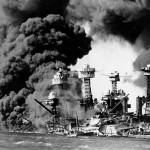
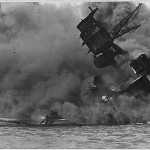 Pearl Harbor’s Block Arena that raised over $50,000. That was more than 10 percent of the USS Arizona Memorial’s final cost. The monument was officially dedicated on May 30, 1962.
Pearl Harbor’s Block Arena that raised over $50,000. That was more than 10 percent of the USS Arizona Memorial’s final cost. The monument was officially dedicated on May 30, 1962.
One of the most surprising facts about the Arizona, however, is related to the fuel. The day before the Pearl Harbor attack, the Arizona had taken on a full load of fuel…nearly 1.5 million gallons, because it was set to make a trip to the mainland later that month. When the Japanese bombers attacked, that fuel played a major part in the explosions and raging fire that followed the bombing. After the fires were put out, there were 500,000 gallons of fuel left in the ship. Now, 75 years later, the Arizona continues to spill up to 9 quarts of oil into the harbor each day. In the mid-1990s, concerns for the environment led the National Park Service to commission a series of site studies to determine the long term effects of the oil leakage. Some scientists have warned of a possible “catastrophic” eruption of oil from the wreckage, which they believe would cause extensive damage to the Hawaiian shoreline and disrupt US naval functions in the area. They continue to monitor the deterioration of the wreck site but are reluctant to perform extensive repairs or modifications due to the Arizona’s role as a “war grave.” In fact, the oil that often coats the surface of the water surrounding the ship has added an emotional gravity for many who visit the memorial and is sometimes referred to as the “tears of the Arizona” or “black tears.”
As surprising as that is, there is still one more fact that many people didn’t know. The bonds between the crewmembers of Arizona have lasted far beyond the loss of the ship on December 7, 1941. Since 1982, the US Navy has allowed survivors of USS Arizona to be interred in the ship’s wreckage upon their deaths. After a full military funeral at the Arizona memorial, the cremated remains are placed in an urn and then deposited by divers beneath one of the Arizona’s gun turrets. More than 30 Arizona crewmen who survived Pearl Harbor  have chosen the ship as their final resting place. Crewmembers who served on the ship prior to the attack may have their ashes scattered above the wreck site, and those who served on other vessels stationed at Pearl Harbor on December 7, 1941, may have their ashes scattered above their former ships. As of November 2011, only 18 of the 355 crewmen who survived the bombing of USS Arizona are known to be alive. I knew that the Pearl Harbor attack had a deep impact on the lives of the survivors, but I guess I didn’t fully understand that it was a life changing event, and it would never really leave them.
have chosen the ship as their final resting place. Crewmembers who served on the ship prior to the attack may have their ashes scattered above the wreck site, and those who served on other vessels stationed at Pearl Harbor on December 7, 1941, may have their ashes scattered above their former ships. As of November 2011, only 18 of the 355 crewmen who survived the bombing of USS Arizona are known to be alive. I knew that the Pearl Harbor attack had a deep impact on the lives of the survivors, but I guess I didn’t fully understand that it was a life changing event, and it would never really leave them.

